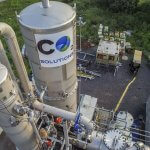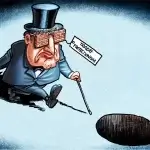Why Suriname’s Carbon Finance Program Could Change The World

Ken Silverstein
Mr. October is on deck. Marciano Dasai, Suriname’s minister of spatial planning and environment, spoke at Climate Week in New York and is pitching 4.8 million carbon offsets to the real heavy hitters — the rich nations responsible for most of the globe’s CO2 emissions.
It’s the World Series of carbon finance — a potential win-win for affluent and emerging countries. The global community must put up or shut up — to disclose their progress regarding their climate targets. Almost all nations will fall short. The good news is they can buy offsets — scrutinized and part of the global accounting system — from Suriname, which will bring them to market in the coming weeks.
“We are carbon negative,” Dasai told me. “We can offer offsets to carbon-positive countries, which can use them to meet their carbon goals. As long as we can help, they are welcome to buy. It is a stepping-stone for us to adapt to rising sea levels and aberrant weather patterns. We can next look to new technologies and renewable energies — the things the developing world can afford to do now.”
Deep breath. If countries are decarbonizing their electricity and transportation sectors and still need to meet their net-zero goals, then buying carbon credits is appropriate. Moreover, they will purchase them from rainforest nations that go above and beyond the call of duty — keeping their trees standing, which are natural CO2 vacuums.
Alternatively, the rainforest nations could allow farmers, loggers, and drillers more access to those lands, defeating the objectives. But they must get paid a competitive price for the “internationally transferred mitigation outcomes” or ITMOs they will sell. Nevertheless, analysts at Climate Week explained to me last week that the current demand is low; greenwashing fears are pervasive.
I am the editor-at-large for the Coalition for Rainforest Nations, comprised of 65 countries with the potential to sell Paris-approved ITMOs issued by national governments and sold to other countries.
For the record, Suriname has 600,000 ethnically diverse people with a per capita income of $5,000 yearly. It runs its economy on hydropower and a small amount of diesel generation. Since independence from the Dutch in 1975, it has relied on natural resources to power its economy — a composition of gold, oil, and bauxite.
Global Stocktake Forces Rich Countries to Act

Gold is the main economic driver, attracting companies like IM Gold from Canada and Zigin from China. Meanwhile, Alcoa AA +3.3% set up the Surinaamsche Bauxite Maatschappij in 1916 to prospect for bauxite. Also, Suriname’s National Energy, Oil, and Gas Co. (Staatsolie) will expand its offshore oil production in 2028.
Forests cover 93% of the country — carbon sinks that benefit the world. The annual deforestation rate is between 0.05% and 0.07%, a product of illegal gold mining. Suriname’s metropolitan areas are located along the coasts and vulnerable to rising seas, while those inland feel the effects of excess water on their crops.
“If Suriname gets off the ground, other countries will get involved. But they must do their due diligence,” Adam Hedley, partner at the Clifford Chance law firm in London, told me. “If the price is right and they check all the boxes, it will snowball. Countries can authorize ITMOs for net-zero purposes.”
Honduras and Belize will follow Suriname’s lead, issuing ITMOs shortly. Honduras and Belize will each issue 10 million ITMOs. Minister Desai of Suriname says the more rainforest nations issuing ITMOs, the merrier; it increases awareness and the demand for credits.
Countries must submit their so-called “global stocktake” in December at COP28 — a snapshot of their climate progress. The United States and others are at a crossroads: this country aims to reduce its CO2 emissions by 25% by 2025 using a 2005 baseline. However, 17% appears more realistic. After that, its goal is to cut its CO2 levels by 50% by 2030. The European Union aims to reduce its CO2 emissions by 55% by 2030 from a 1990 baseline.
Governments set emissions limits, and those that exceed them can sell credits to those unable to do so. As the ceiling lowers, CO2 levels fall. But carbon credits are not without controversy: If a country uses offsets instead of deploying more renewables, activists will accuse them of “greenwashing.”
“The environment for offsets is too controversial now to make significant moves,” Charles Boakye, equity analyst at Jeffries told me. “We are waiting for the temperature to die down. However, ITMOs are a credible vehicle and the circumstances will change.”
No one suggests the developed world achieves carbon neutrality using only carbon credits. However, the energy transition needs to happen faster, and countries will need assistance to hit their net-zero goals. The climate quest is on, creating friction between traditional and clean energies, an industry that created 13.7 million jobs in 2022, says the International Renewable Energy Agency.
Indeed, the economy and environment are linked. Enter Suriname, which is rolling out 4.8 million offsets. If Mr. October — Marciano Dasai — has his way, the credits will sell for $30 a ton, generating jobs and preserving rainforests. Call it the World Series of carbon finance, where there’s a world of difference between winning and losing.









